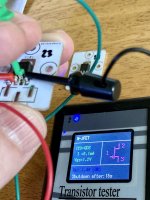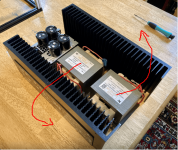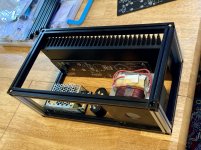Nice work Von Ah! How did they check out? I bet they are fine as these are robust little devices. I just sent off 600 of these to the board house for robotic pick and place installation onto the IMS boards. Then they come back and Woofertester will do the characterization and matching for me with a new dedicated auto-test rig.
Cool and interesting! Is there a description of the rig and the test procedures?....characterization and matching for me with a new dedicated auto-test rig.
I’ll let @woofertester describe it if he wants to. I know he uses a professional grade Keithly bench DMM and some custom python code plus some custom PCB jigs. He will also be characterizing about 1200 IRFP240’s to make the matched triplet Cascode.
I’ll let @woofertester describe it if he wants to. I know he uses a professional grade Keithly bench DMM and some custom python code plus some custom PCB jigs. He will also be characterizing about 1200 IRFP240’s to make the matched triplet Cascode.
My test rig is a Keithley 2602B dual-channel sourcemeter and Python code that I wrote. The test sets Vds at the voltage that will be used in the applicaiton. Vgs is swept (varied from some low voltage to some higher voltage) until the intended bias current of the application is reached. Calculations are made to extract gm (gain) and Vgs. A garden variety receipt printer is used to print out the results for posterity.
My day job involves knowing how to do these sorts of tests. It is a good exercise for sharpening my skills and indulging in my audio hobby.
Nice. I quickly looked up the Keithley 2602B. This thing costs more than a new car! How is it different from a conventional programmable two-channel bench PSU that costs ten times less?My test rig is a Keithley 2602B dual-channel sourcemeter and Python code that I wrote. The test sets Vds at the voltage that will be used in the applicaiton. Vgs is swept...
And then you still need to put a label on the part itself so it can be identified later. How do you do this? In my experience with part testing and matching, labelling is the most annoying part for me.A garden variety receipt printer is used to print out the results for posterity.
Professional grade test equipment is generally in the tens of $k. I don’t know any new cars for $13k. 🙂 The accuracy, stability, and ruggedness are factors I suppose. 10A / 40V range with 100fA / 100nV resolution makes this immediately something that’s special.
Good question on labeling. Small zip lock bags work but that can be a lot for 600 of them. Maybe special trays with a matrix label and a spreadsheet?
Good question on labeling. Small zip lock bags work but that can be a lot for 600 of them. Maybe special trays with a matrix label and a spreadsheet?
Ok, these resolution numbers are quite impressive. However, this kind of resolution is way over the top for this and many other part testing/matching applications. All you need is a common-garden PSU with about three/four orders of magnitude less resolution.... with 100fA / 100nV resolution makes this immediately something that’s special.
Last edited:
Agreed, but since Woofertester has the gear already, why not? Some people have an Audio Precision in their lab, they should use it!
Thanks, x.Nice work Von Ah! How did they check out? I bet they are fine as these are robust little devices. I just sent off 600 of these to the board house for robotic pick and place installation onto the IMS boards. Then they come back and Woofertester will do the characterization and matching for me with a new dedicated auto-test rig.
I merely measured them with the transistor tester and they all were similar in the values in the picture, so I deduced that they were all ok. It's possible I cooked all of them, too, but I thought that was unlikely. 😀
Woofertester, your testing rig sounds fabulous.
My SMPSs arrived (Meanwell RPS-200-27) so I'll do some more LuFo planning and part ordering today.
Playing around with some placement options, using makerbeam for testing. Heatsinks are 3U300.
More elaborate ideas include a central spine of heatsinks with fins pointing at each other, with fans below or above.
The caps here are just concept placeholders, not the ones I’ll use for the amp.
More elaborate ideas include a central spine of heatsinks with fins pointing at each other, with fans below or above.
The caps here are just concept placeholders, not the ones I’ll use for the amp.
Attachments
-
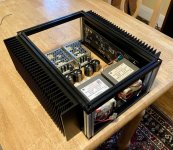 2C7399E8-B73E-4306-B6EA-4D1E08090DB6.jpeg660.5 KB · Views: 258
2C7399E8-B73E-4306-B6EA-4D1E08090DB6.jpeg660.5 KB · Views: 258 -
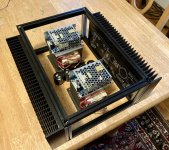 92AE73E0-7D05-4EFE-BE86-6E040E18060B.jpeg728.9 KB · Views: 228
92AE73E0-7D05-4EFE-BE86-6E040E18060B.jpeg728.9 KB · Views: 228 -
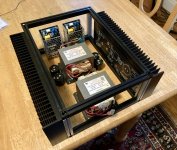 8F9928B1-96D2-4BBE-BF4F-0045E9E1E181.jpeg617.7 KB · Views: 230
8F9928B1-96D2-4BBE-BF4F-0045E9E1E181.jpeg617.7 KB · Views: 230 -
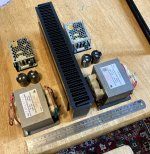 9FBACE52-B2C9-41F8-B48D-A1C9D63AF121.jpeg886.9 KB · Views: 222
9FBACE52-B2C9-41F8-B48D-A1C9D63AF121.jpeg886.9 KB · Views: 222 -
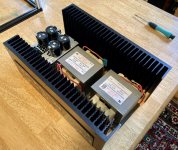 5D89A1D5-D678-4D66-B4CC-CC3932D9AC39.jpeg665.1 KB · Views: 227
5D89A1D5-D678-4D66-B4CC-CC3932D9AC39.jpeg665.1 KB · Views: 227
Last edited:
Yep. Just a makerbeam XL box 330x230x130. I love working with it, too. Every time I play with it I think all my diy builds should use it. Even speaker cabinets. 😆
I like this with smps in slim side verticalPlaying around with some placement options, using makerbeam for testing. Heatsinks are 3U300.
More elaborate ideas include a central spine of heatsinks with fins pointing at each other, with fans below or above.
The caps here are just concept placeholders, not the ones I’ll use for the amp.
Attachments
Thanks, nicoh. Like this?
It’s a bit wider than I was aiming for, (over 300mm wide), so that leads to monoblocks. Plenty of options/configurations for compact mono’s, but I wanted to try to hurt my back first. 😆 Makes me think of those very cool Kenwood L-series monoblocks from the 80s…
It’s a bit wider than I was aiming for, (over 300mm wide), so that leads to monoblocks. Plenty of options/configurations for compact mono’s, but I wanted to try to hurt my back first. 😆 Makes me think of those very cool Kenwood L-series monoblocks from the 80s…
Attachments
My vote is for Pic#1
https://www.diyaudio.com/community/attachments/2c7399e8-b73e-4306-b6ea-4d1e08090db6-jpeg.1058510/
Shouldn’t be too heavy since your going with SMPS for power. Will those MeanWells power-up with the added capacitance at the outputs?
https://www.diyaudio.com/community/attachments/2c7399e8-b73e-4306-b6ea-4d1e08090db6-jpeg.1058510/
Shouldn’t be too heavy since your going with SMPS for power. Will those MeanWells power-up with the added capacitance at the outputs?
Must avoid choke magnetic coupling ..... are cubic the choke ? just to gain some cm.....Thanks, nicoh. Like this?
It’s a bit wider than I was aiming for, (over 300mm wide), so that leads to monoblocks. Plenty of options/configurations for compact mono’s, but I wanted to try to hurt my back first. 😆 Makes me think of those very cool Kenwood L-series monoblocks from the 80s…
PS I have had a stereo xo in a single box and one disconnect channel sound without to the amp ! 🙂
pic4 is nice too and the 2 for classic design but with one choke turn 90°
Last edited:
I was thinking the same thing. You can rotate one of the chokes 90 by mounting it on a bracket to get orthogonal plane. Not sure how big a problem with EI cores. With air core it was audible. I got sound without amp even connected when one XO was near the other. My video on XO crosstalk.
EI psu iron have a lot of magnetic gremlins vs toro or Rcore.....btw he the filter better AC as have low bandwith
Pic#1 would indeed be simplest, with rotating one MOT 90 degrees. I intend to test an inline NTC with the SMPS output for each channel first. I’m optimistic that will work. If not I can incorporate a more elaborate soft start scheme, or change to a different SMPS like MicroAudio or Connex.My vote is for Pic#1
Shouldn’t be too heavy since your going with SMPS for power. Will those MeanWells power-up with the added capacitance at the outputs?
Here’s another monoblock idea. I have just enough space in my rack for two of these side by side. 180x130x330. Enclosed heatsink is a different look and kinda cool.
Attachments
- Home
- Amplifiers
- Pass Labs
- LuFo Amp - 39w SE Class A from 28v Rail
